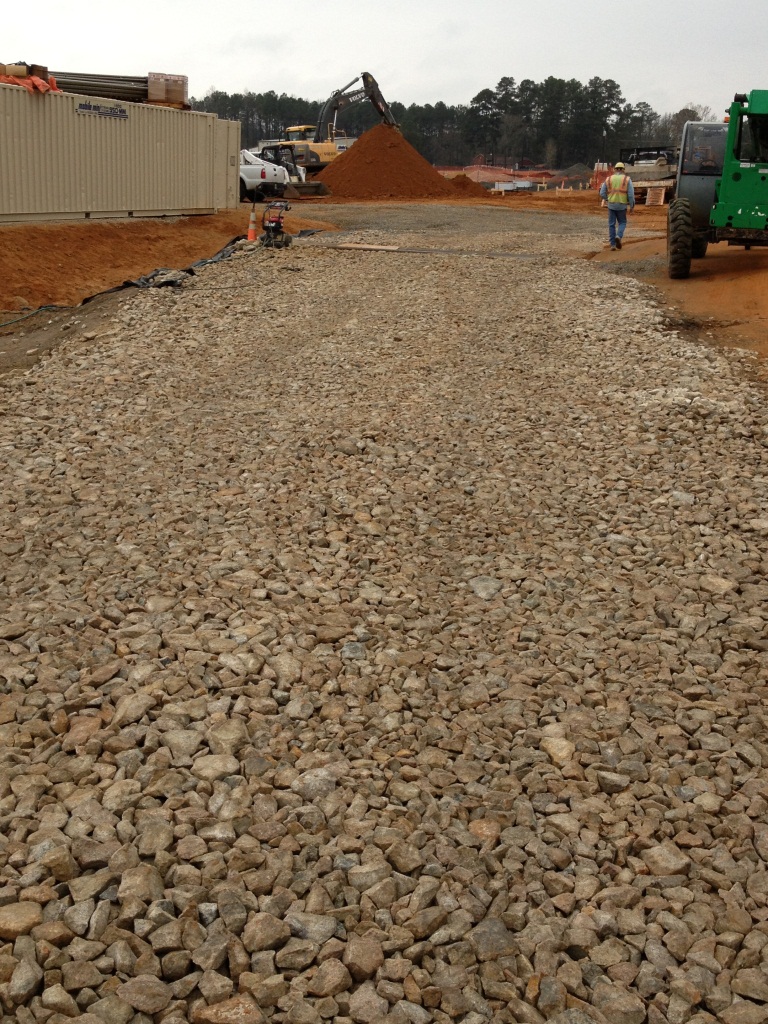Construction Entrance

Definition
A temporary stone-stabilized pad located at points of vehicular ingress and egress on a construction site.
Purpose
To provide a stable entrance and exit from a construction site and keep mud and sediment off public roads.
Advantages
- Mud on vehicle tires is significantly reduced which avoids hazards caused by depositing mud on the public roadway.
- Sediment, which is otherwise contained on the construction site does not enter stormwater runoff elsewhere.
Disadvantages
- Effective only if installed at every location where traffic leaves and enters the site.
Planning Considerations
- Avoid locating at curves in public roads or on steep slopes.
- Construction entrances provide an area where mud can be removed from vehicle tires before they enter a public road. If the action of the vehicle traveling over the gravel pad is not sufficient to remove the majority of the mud, then the tires must be washed before the vehicle enters a public road.
- If washing is used, provisions must be made to intercept the wash water and trap the sediment before it is carried off-site. Construction entrances should be used in conjunction with the stabilization of construction roads to reduce the amount of mud picked up by vehicles.
- This practice will only be effective if sediment control is used throughout the rest of the construction site.
Design Recommendations
- Remove all vegetation and other objectionable material from the foundation area. Grade and crown foundation for positive drainage.
- Stone for a stabilized construction entrance shall be 1 to 3-inch stone, reclaimed stone, or recycled concrete equivalent placed on a stable foundation as specified in the plan.
- Pad dimensions: The minimum length of the gravel pad should be 50 feet, except for a single residential lot where a 30 foot minimum length may be used. Longer entrances will provide better cleaning action. The pad should extend the full width of the construction access road or 10 feet whichever is greater. The aggregate should be placed at least six inches thick.
- A geotextile filter fabric shall be placed between the stone fill and the earth surface below the pad to reduce the migration of soil particles from the underlying soil into the stone and vice versa. Filter cloth is not required for a single family residence lot.
- If the slope toward the road exceeds 2%, construct a ridge, 6 to 8 inches high with 3:1 side slopes, across the foundation approximately 15 ft from the entrance to divert runoff away from the public road. All surface water that is flowing to or diverted toward the construction entrance should be piped beneath the entrance. If piping is impractical, a berm with 5:1 slopes that can be crossed by vehicles may be substituted for the pipe.
- Washing: If the site conditions are such that the majority of mud is not removed from the vehicle tires by the gravel pad, then the tires should be washed before the vehicle enters the road or street. The wash area should be a level area with 3-inch washed stone minimum, or a commercial rack. Wash water should be directed into a sediment trap, a vegetated filter strip, or other approved sediment trapping device. Sediment should be prevented from entering any watercourses.
- A filter fabric fence should be installed down-gradient from the construction entrance in order to contain any sediment-laden runoff from the entrance.
Common Trouble Points
- Inadequate runoffcontrol: Sediment washes onto public road.
- Stone too small, pad too thin, or geotextile fabric absent: Results in muddy condition as stone is pressed into soil.
- Pad too short for heavy construction traffic: Extend pad beyond the minimum 50-ft length as necessary.
- Pad not flared sufficiently at road entrance: Results in mud being tracked onto road and possible damage to road edge.
- Unstable foundation: Use geotextile fabric under pad and/or improve foundation drainage.
Maintenance
- The entrance should be maintained in a condition that will prevent tracking or flowing of sediment onto public rights-of-way. This may require periodic topdressing with additional stone.
- Inspect entrance/exit pad and sediment disposal area weekly and after heavy rains or heavy use.
- Remove mud and sediment tracked or washed onto public road immediately.
- Mud and soil particles will eventually clog the voids in the gravel and the effectiveness of the gravel pad will not be satisfactory. When this occurs, the pad should be top-dressed with new stone. Complete replacement of the pad may be necessary when the pad becomes completely clogged.
- If washing facilities are used, the sediment traps should be cleaned out as often as necessary to assure that adequate trapping efficiency and storage volume is available. Vegetative filter strips should be maintained to insure a vigorous stand of vegetation at all times.
- Reshape pad as needed for drainage and runoff control.
- Repair any broken road pavement immediately.
- All temporary erosion and sediment control measures shall be removed within 30 days after final site stabilization is achieved or after the temporary practices are no longer needed. Trapped sediment shall be removed or stabilized on site. Disturbed soil areas resulting from removal shall be permanently stabilized.
References
Minnick, E. L., and H. T. Marshall, Stormwater Management and Erosion Control for Urban and Developing Areas in New Hampshire, Rockingham County Conservation District, August 1992.
North Carolina Department of Environment, Health, and Natural Resources, Erosion and Sediment Control Field Manual, Raleigh, NC, February 1991.
U.S. Environmental Protection Agency, Storm Water Management For Construction Activities EPA832-R-92-005, Washington, DC, September, 1992.
Washington State Department of Ecology, Stormwater Management Manual for the Puget Sound Basin, Olympia, WA, February, 1992. Main Erosion and Sedimentation Control BMPs. http://www.maine.gov/dep/blwq/docstand/escbmps/index.htm